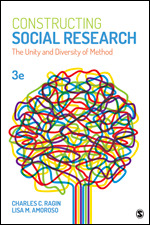Constructing Social Research
The Unity and Diversity of Method
- Charles C. Ragin
- Lisa M. Amoroso - Dominican University
The updated Third Edition of this innovative text shows the unity within the diversity of activities called social research to help students understand how all social researchers construct representations of social life using theories, systematic data collection, and careful examination of that data. The book tackles questions like "What is social research?", "How does it differ from journalism, documentary film-making, or laboratory research in the natural sciences?", and "What is the researcher's obligation to those he or she is studying?"
Updated throughout with new references and examples, this edition is designed to evoke challenging questions regarding the nature of representation and the ethical challenges facing social scientific researchers. The text moves beyond standard research challenges to push readers to see the complex relationships among ethics, ideas, evidence, and outcomes.
Treats research appropriately as an epistemological action of queries and interplay between induction and deduction. Other research textbooks tend to exclusively focus on the mechanics of the research process.
The authors' approach is helpful for students new to research and analysis. It allows me, within 4 months, to take students with no knowledge of sociological studies other than a cursory description of findings in an introductory class to a mastery level where they are able to conduct and write up an an original study.
Best book ever!
The text is well written an researched.
Sample Materials & Chapters
Chapter 1. What Is (and Is Not) Social Research?
Chapter 3. The Process of Social Research: Ideas and Evidence

